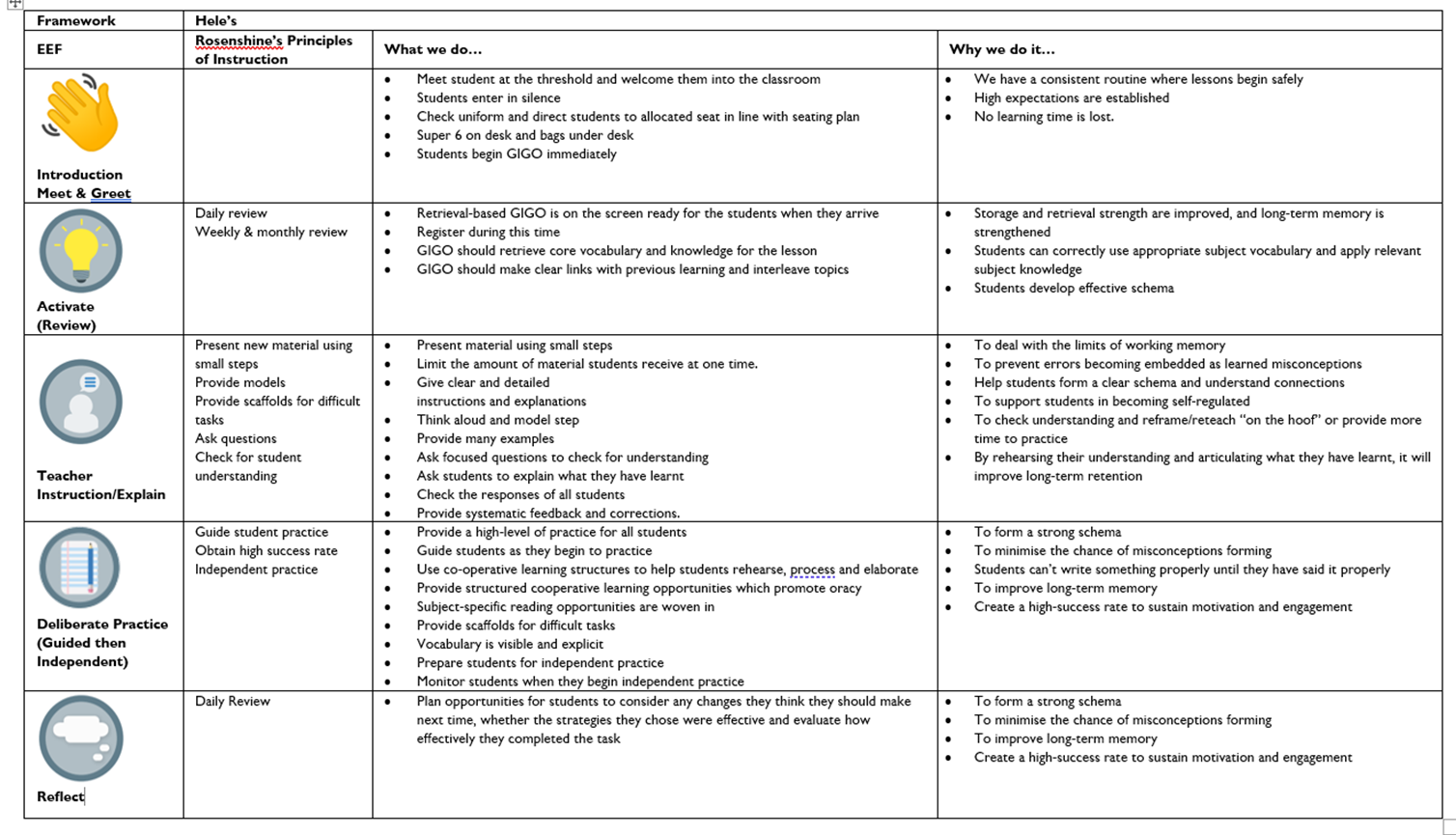Curriculum Implementation
The Hele's Model of Learning
The curriculum is planned through schemes of learning; comprehensive documents that map out the academic journey for every Hele’s student. The fundamental principles of the Hele’s School curriculum are outlined in this section. Before reading this section, it is worth noting that it represents our current thinking regarding a process that began back in 2017. The curriculum constantly evolves and improves (as does the thinking behind it) so it is reasonable to assume that the contents of this section will evolve alongside it.
An effective scheme:
- underpins a comprehensive and cohesive learning experience for all learners; provides clear information how a subject helps students’ learning and attainment;
- identifies the contributions the department makes towards whole school and cross-curricular priorities; provides a clear line of progression in both planning and delivery;
- demonstrates how curriculum content, teaching and learning and the use of assessment are organised; requires teachers to work together to plan a coherent programme; and helps teachers plan common activities, resources, & individual lesson plans.
Expectations of Long-Term Planning (LTP)
LTP will map the delivery of a course across an extended period (e.g. year or Key Stage), and will show the sequencing of the course, illustrating:
- time allocation of all units to ensure full coverage of curriculum requirements
- how this curriculum builds on previous Key Stages
- progression throughout the course, both in terms of skills and knowledge key assessment points as per school calendar
- interleaving of knowledge to support memory for learning
Expectations of Medium- Term Planning (MTP)
MTP will map the delivery of an individual unit across a defined period, and will reference:
- time allocation
- Key Concepts
- Learning Objectives and Success Criteria
- Essential activities for in-class/ home learning
- Additional activities for teachers to dip in to
- These activities are linked to high quality resources
- Wider skills coverage
- Formative/summative assessment
- DIRT
All Medium-Term Plans should be linked explicitly to a Knowledge Organiser
Short-Term Planning (STP)
All short-term plans (lesson plans) should have a core which have been planned collaboratively and reference:
- GIGO task foucsed on retrieval of prior knowledge relevant to the lesson
- Learning objectives/title
- The EEF symbols to show the 5 stages of a lesson
- Introduction
- Activate
- Explain
- Practise
- Reflect
- Essential agreed activates
- Essential core assessment tasks
Beyond this agreed format, teachers will adapt Short Term Plans to meet the needs of the individual students in front on them.

 Full size image
Full size image
Challenge & Expectations
“We establish what we establish.” Bill Rogers
“High expectations should be tattooed inside our hearts for every child, until the minute they leave school for good—maybe not even then.” Tom Bennett
Introduction
Having high expectations, communicating them and reinforcing them is a powerful feature of great teaching. By sweating the small stuff you show that you really believe that excellence is possible from everyone. If you don’t expect them to be able to do it, they never will. Don’t accept mediocrity; insist on excellent behaviour; pay attention to details of the subject content, delivering and expecting clarity and precision; push students to find even deeper levels of meaning.
Evidence Base
One consistent finding of academic research is that high expectations are the most reliable driver of high student achievement, even in students who do not have a history of successful achievement. Much of this research has been centred around the ‘Pygmalion Effect”, in which teachers are told that randomly selected groups of students have very high test scores and have the potential for high academic gains. Rosenthal and Jacobson have noted, “when teachers expected that certain children would show greater intellectual development, those children did show greater intellectual development”. The Pygmalion Effect has found to be most pronounced where teachers start the school year with high expectations and build them in from the start. No one rises to low expectations. Having high expectations of every student and providing the necessary support needed to achieve that level is key to all students achieving to their best ability. Robert Bjork’s concept of desirable difficulties suggests that introducing certain difficulties into the learning process can greatly improve long-term retention of the learned material. so, if we get the learning right, both memory, retention, and performance is improved. But learning is not easy, and both students and their teachers might resist - wishing for that simpler task, which requires minimal effort of brain power.
What does it look like?
How do you know if you are challenging your students enough? The only way to find the limits is to push students beyond them. Try a bit of deep-end challenge and see where they get stuck. If we establish that we expect high standards and reinforce them continually with tight routines in lessons characterised by rigour, depth, drive and a clear sense of purpose, that is what we get. If we establish that we will insist on polite, respectful interactions, listening to whoever is speaking and acting in a supportive, mature fashion, then students will learn the boundaries and respond. The pitch of your lesson is an expression of your expectations. If you set students the task of doing something gentle like a poster or title page you send a clear message that the expectation is low.
Literacy
Click here for information regarding literacy at Hele’s School.
Memory for Learning
Introduction
Memory and learning are so closely connected that it is easy to confuse them with each other. Learning can be defined as “the retention and transfer of knowledge and skills” whereas memory is the ability to remember past experiences. You learn a new language by studying it, but you then speak it by using your memory to retrieve the words that you have learned. Memory is essential to all learning because it lets you store and retrieve the information that you learn.
Evidence Base
Thirty years ago, little was known about how memory works, but now we know a great deal. Psychologists and neurologists have divided memory into two broad categories: working memory and long-term memory. Long-term memory is often associated with arithmetic, such as recalling 5x7=35 or that the capital of France is Paris. Working memory is often thought of as a mental workspace that we can use to store important information on the course of our mental activities. However, whilst the capacity of our long-term memory is unlimited, our working memory can only process 3-5 pieces of information at a time.
Psychologists think about long-term memory as organised into schemas, or interconnected webs of concepts, facts, impressions and ideas. The most successful learning happens when students can piece the jigsaw together and see how their learning links together. Schemas ensure effortless access to basic facts and concepts that are repeated over and over in our subjects. Daniel Willingham says, “The more you know, the easier it will be for you to learn new things.” This is the advantage that our students with good cultural/general knowledge have. We need to ensure we help build this for all.
Absence of a relevant schema means students must use less process-intensive strategies and because they can’t chunk the material effectively, their working memory can easily become overloaded. Remember, our working memory can only hold 3-5 pieces of information at any one time, so we need to help students develop schemas to avoid their working memory being overloaded.
Research shows that when we transfer information from our working memory to our long-term memory, learning takes place.
What does it look like?
Daniel Willingham says, “Memory is the residue of thought”. This means that students must be motivated and paying attention to their learning so that they process their learning. If they think about it and we challenge them, they’ll remember it. If we make learning too easy, it’ll be lost. This is known as desirable difficulties - the harder our brain works and the more we think, then the more we remember. Engagement and challenge are key, so cooperative learning strategies to encourage talk for learning are important.
Students as Partners in Learning
Introduction
To develop students as partners in the learning process requires us to create a culture where opt-out is removed and students are trained to be self-regulated learners. They need to understand how they learn and confidently use strategies to plan, monitor and evaluate their work. Our most effective learners model these behaviours, but we need to model these explicitly for all students.
Evidence Base
The EEF Teaching and Learning Toolkit highlights that self-regulation approaches have consistently high levels of impact, with students making an average of seven months’ additional progress.
These strategies are usually more effective when taught in collaborative groups so that learners can support each other and make their thinking explicit through discussion.
The potential impact of these approaches is high but can be difficult to achieve in practice as they require pupils to take greater responsibility for their learning and develop their understanding of what is required to succeed.
The evidence indicates that teaching these strategies can be particularly effective for low achieving and older pupils.
What does it look like?
- This work is multi-faceted and includes:
- Teachers modelling what to do and how to do it
- Teachers modelling their thought-processes and choices
- Live modelling
- Providing opportunities for students to reflect on what worked, what didn’t, the reasons for this and next steps
- Co-operative learning structures used to avoid opt-out
- An expectation that all students respond to the feedback and take ownership of improving
Expectations of Hele's Staff
In this section, we outline what is expected of every teacher at Hele’s School. Departments may use their own individual systems and strategies but by adopting a consistent approach to cooperative learning, marking, DIRT, assessment and home learning, we can be consistent in expecting the best from our students.
COOPERATIVE LEARNING
Introduction
Cooperative learning is a structured approach to learning that is designed to actively engage every student.
‘Structures’ are a content free set of repeatable steps that organise the interaction of students with the lesson content, each other and the teacher. All students should benefit from the coaching, encouragement and feedback that cooperative learning provides.
Evidence Base
The Education Endowment Foundation have found that over 40 years evidence about the benefits and impact of cooperative learning has been consistently positive if done well. Effective cooperative learning requires well-designed tasks, which promote talk and interaction between learners to result in the best gains.
What does it look like?
Cooperative learning structures are based on the following principles (PIES):
- Positive interdependence – students need each other to complete the task, the success of one is linked to the success of the other.
- Individual accountability – each student is accountable for their own contribution; they cannot hide behind teammates.
- Equal participation – everyone must participate, there is no opt-out.
- Simultaneous interaction – many students are participating at once maximising positive outcomes in cooperative learning.
Further resources can be found on the T: drive → Cooperative Learning.
GREEN PEN MARKING AND DIRT
Staff will adopt the following consistent practice:
- WWW (what went well) - comments on the progress in line with learning outcomes or praise comment.
- EBI (even better if) - comments on what to do to improve or achieve their next steps in learning. Students often find this useful when this is phrased as a question.
Green pen marking and DIRT are expected to enable learners to improve their work, to apply the feedback in a new context or to improve substandard work.
GPM during DIRT time is a crucial part of the learning process and ensures that self/peer/teacher assessment has maximum impact.
Students use it most effectively when they are reminded of its value (i.e. to make progress and practice their improvements) rather than seeing it as a task. We need to remind them that it takes practice to achieve quality.
“It’s how professional writers, artists, scientists produce excellent work in the real world. They take more care over their work; they understand that progress is earned step by step through the progress of action and reflection; and they develop competence and self-esteem by comparing the progress they have made from their early drafts to the finished work”.
Griffith and Burns, Teaching Backwards
SELF AND PEER ASSESSMENT
We recognise the value of learners assessing both themselves and their peers as part of the wider programme of assessment for learning:
- Ensures student engagement in learning dialogue
- Forces students to proofread their work before handing it in
- If students have meaningful success criteria, it enables then to ’think like an examiner’, thereby better understanding what is required of them
Homework
“The evidence shows that the impact of homework, on average, is five months of additional progress.” Education Endowment Fund.
Homework is a critical part of delivering the curriculum and needs to be treated as such. It is not an optional extra (for either staff or students). Used effectively it can aid students’ understanding of a subject, allow students to explore certain aspects of the subject in more depth, and develop students’ research skills. More importantly however, setting homework is one of the main ways in which a school can instil a sense of self-motivation in its students as well as the recognition that learning is done both at school and at home. Successful students will be those who put in the hours, working hard at home as well as at school. Setting useful and regular homework right from the start of year 7 is vital if we are to create a work ethic in students that encompasses both work which is undertaken at school and work done at home.
Our belief
Homework is an intrinsic part of education and allow students the opportunity to pursue learning independently. As well as supporting subject specific knowledge, homework enables students to develop skills and habits essential to making good progress. We believe that homework should be a valid and relevant activity which allows students to build their knowledge move their understanding forward. Staff should have the freedom and flexibility to set home learning as appropriate within a sequence of lessons but should be mindful of the time scales below.
|
|
KS3 |
KS4 |
KS5 |
|
Maths |
1 hour Sparx online every week; self-marking compulsory tasks plus additional Target/ XP Boost as necessary to make up to 60 mins |
1 hour Sparx online every week; self-marking compulsory tasks plus additional work from Revision/ Independent Learning/ Fix-up sections as necessary to make up to 60 mins as minimum |
All subjects should be setting up to 10 hours of homework/ wider reading a fortnight |
|
English |
Knowledge Quiz and Reading Quiz every week |
Knowledge Quiz and Exam Practice (application of knowledge) every week |
|
|
Science |
30 minutes a week. Online knowledge retrieval via Educake |
90 minutes a week ( 30 mins on each of Biology, Chemistry and Physics). Online knowledge retrieval via Educake |
|
|
Other subjects |
Up to 30 mins a week |
Up to an hour a week |
Expectations of staff:
Staff will:
- set all work on Classcharts (KS3 and KS4) or Teams (KS5) according to the guidance above.
- ensure all tasks set have robust learning objectives that will move learning forward for the individual pupil.
- give clear guidance is given as to the length of time the activity should take and the location of any resource which is necessary to complete the activity.
- give a clear deadline by which the work should be completed. This should not be the next day unless in exceptional circumstances.
- check homework is completed with effort, and for the deadline, and follow up where this is not the case
- assign a Behaviour Point and put a student into a 30 min catch-up session where homework is not completed to the expected standard/ timescale.
Expectations of pupils:
Pupils will:
- spend the expected amount of time and effort on the given task.
- ensure homework is submitted by the deadline date.
- seek help or assistance if stuck or unsure, before the deadline.
- take responsibility for working hard and completing all work set.
- improve work by responding to feedback given.
We ask parents to support by:
- checking class charts to confirm home learning homework has been set unchecked deadlines
- taking an interest in the work being set for your child and talk to them about their learning
- providing a suitable environment for homework to be completed
- feeding back any issues related to the completion of homework is to the specific member of staff or to the tutor
- supporting the school in light of any sanctions in regards to the non-completion of homework
Non completion of homework will result in a student being assigned a Behaviour Point and directed to attend a 30-min catch-up session. These sessions run every day after school until 03:40pm.
Curriculum Implementation: Delivery
The document below is used by all teaching staff at Hele’s and represents our current thinking regarding optimal curriculum development and delivery. The research and guidance outlined in Curriculum Implementation forms a single reference point for staff as they plan, design and deliver our curriculum.
January 2023 Handbook - click here






